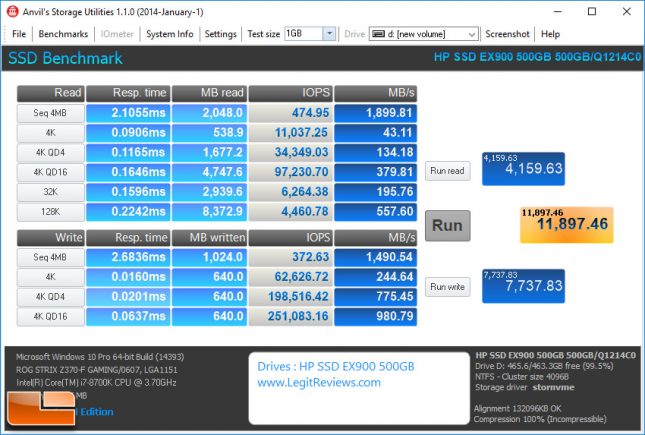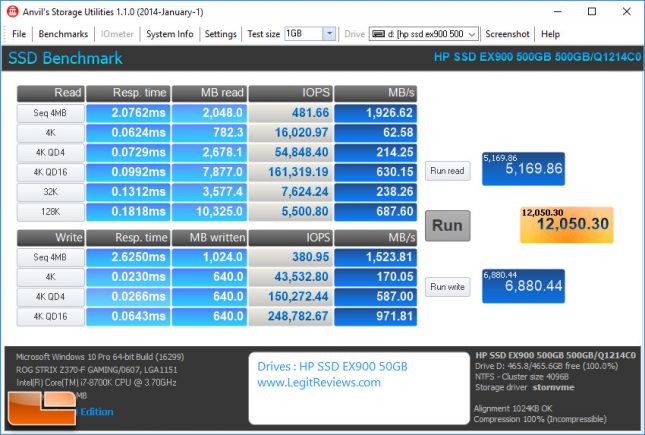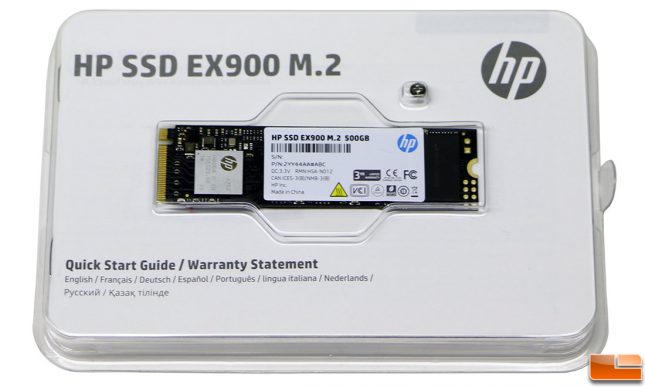HP EX900 500GB M.2 PCIe NVMe SSD Review
Final Thoughts & Conclusions
We weren’t sure what to expect from this Hewlett-Packard (HP) SSD EX900 M.2 drive since it features a DRAM-less design, but we were pleasantly surprised by the performance on a system running the latest version of Windows 10. Our testing showed the HP SSD EX900 M.2 500GB topped out at 2043 MB/s read and 1584 MB/s write in the standard sequential benchmark in CrystalDiskMark and that is close to the drives rated speeds of 2100/1500. When it comes to 4K Random Read/Write IOPS this drive is rated at 120K/110K and we came up with 243K/250K in our testing. When we tested real world performance situations like transferring a 30GB folder full of movies or loading a game, the HP SSD EX900 M.2 500GB drive did much better than expected. Again, we did all our testing on Windows 10 where the DDR4 system memory was being utilized by this DRAM-less design that supports the Host Memory Buffer (HMB) architecture. If you run an older OS or an early build of Windows 10 that hasn’t been updated the performance will be lower. We noticed


We noticed 4K Random Read QD16 performance dropped from 160,000 IOPS to 97,000 IOPS, which is nearly a 40% performance drop. QD1 performance also dropped 30%, so Random Read performance is certainly lower. 4K Random Write performance is better on the old OS, but keep in mind that is without all the Windows 10 Spectre and Meltdown patches being applied.
When it comes to any entry-level drive the most important factor after capacity is usually price. The HP SSD EX900 series is priced at $0.50 per GB or less, depending on what capacity you get.
HP SSD EX900 M.2 Series Pricing
- HP SSD EX900 120GB – $59.99 shipped ($0.50 per GB)
- HP SSD EX900 250GB – $94.52 shipped ($0.38 per GB)
- HP SSD EX900 500GB – $179.99 shipped ($0.36 per GB)
These prices are pretty low, but the HP SSD EX900 500GB drive we reviewed today at $179.99 shipped is going to face a ton of competition. For example the MyDigitalSSD SBX 512GB drive is available for $149.99 shipped and has 1600/1300 MB/s read/write speeds, a 375 TBW endurance rating and a 5-year warranty. You also have the ADATA XPG SX7000 512GB drive at 1800/850 MB/s with an endurance rating of 320 TBW and a 5-year warranty for $154.99 shipped as well as the ADATA XPG SX8000 512GB with 2500/1100 MB/s speeds and the same endurance/warranty specifications for $179.99 shipped. There is no shortage of great performing 500-512GB drives in the $150 to $180 price range.
At the end of the day the HP SSD EX900 M.2 500GB drive performed well in our testing on Windows 10. When this drive came out a couple months back it looked to be a price versus performance winner, but there are a plethora of new drives coming out right now. The HP SSD EX900 M.2 series looks to be good, but it doesn’t stand out from the crowd. The whole point of going with a DRAM-less design is to reduce the BOM cost, yet we don’t feel like that savings is passed through consumer when we look at current street pricing. Case in point, the big brother to this drive is the HP SSD EX920 M.2 512GB and it has 3200/1800 MB/s read/write speeds with the traditional DRAM design and the same endurance and warranty ratings for $199.99 shipped. So, for $20 more bucks you get roughly 52% faster sequential read speeds and 20% faster sequential write speeds. The Random 4K performance also goes from 120K/110K up to 340K/260K, so on paper the Random read performance nearly triples. You also don’t have to worry about what OS you are using or OS patches messing anything up as it has DRAM included on the HP SSD EX920 M.2 drive series. We are currently working on a review of the HP SSD EX920 M.2 drive, so stay tuned for that.
That makes the HP SSD EX900 tough to recommend unless you can pick it up for an amazing price. An amazing price would be in the $125-$150 price range for the 500GB model and we have seen drives go that low in this class for special promotions.
Legit Bottom Line: The HP SSD EX900 500GB drive performs well for a budget NVMe drive, but you’ll need the latest build of Windows 10 to get the best performance from this DRAM-less drive.

